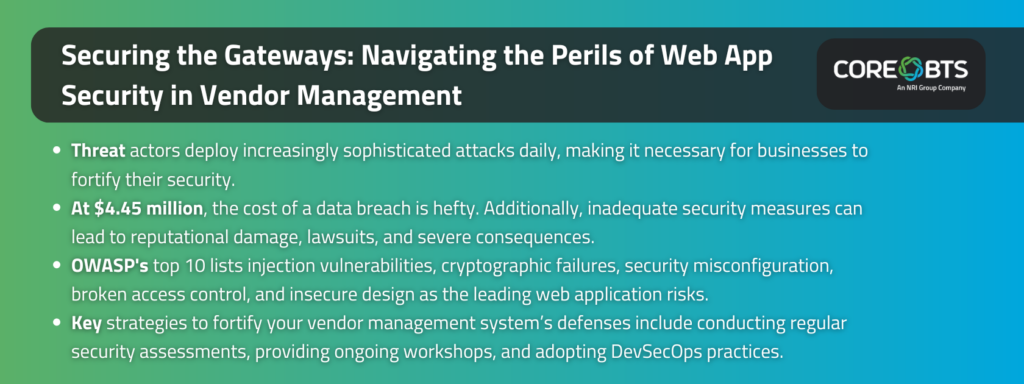
Most modern businesses understand that building secure web applications is a non-negotiable priority to thrive in today’s ultra-competitive landscape. That’s especially true for vendor management systems where a breach can trickle down to other companies you do business with.
Yet many fail to hit the mark in developing resilient solutions. When that happens, it’s often due to using the wrong approach rather than inadequate effort.
The cybersecurity landscape has changed a lot in recent years. The reactionary approach of including security as an afterthought is not practical. To make vendor management web applications more resilient against modern threats, security must be part of every stage of the software development lifecycle (SDLC). That’s where ongoing testing, training, and DevSecOps come in handy.
Criticality of Safeguarding Web Applications in Vendor Management
Security flaws in web applications are widespread. Veracode’s 2024 software security report shows that approximately 80% of all active web applications have unresolved security issues. More concerning, roughly 70% have the most critical security risks listed in the Open Worldwide Application Security Project (OWASP) Top 10.
With threat actors actively honing their craft and finding better ways to exploit applications, businesses must evolve their capabilities. Attacks are becoming more challenging to detect, more sophisticated, and more potent in their potential damage to your reputation, data, and networks.
Recent IBM estimates place the cost of a data breach at $4.45 million. This reinforces the importance of adopting proactive security strategies, including penetration testing, vulnerability assessments, and continuous monitoring to find and fix security issues before they become problematic.
The earlier in the development lifecycle you can identify and resolve security flaws, the safer your company and its vendors will be. Many serious vulnerabilities can occur in the initial stages of development, including corrupted open-source components and subtle coding errors, so it’s crucial to run security assessments at every step.
Because humans are fallible, errors are bound to happen during development, and the challenge is to catch them as quickly as possible. For example, a simple coding error that allows unverified inputs could leave the vendor management system open to SQL injection attacks and data leaks if threat actors find them. Luckily, a proactive security stance can keep this from happening.
Integrating security tools into your development environment streamlines security workflow and processes, helping you catch vulnerabilities early. These tools are also helpful for security audits as they save money and time by helping you fix problems before auditors find them.
Gone are the days when IT teams would take months to refine, build, test, and deliver a vendor management system. Today, we have new continuous integration and deployment methods that refine web apps hourly or daily, helping find issues with code quickly.
Common Software Vulnerabilities
One way to stay informed of web application security flaws that cybercriminals are likely to exploit is the OWASP Top 10 list. The list describes the 10 most critical web application security risks and how to mitigate them. OWASP compiles the list from vulnerability databases, community surveys, and expert-contributed information about common vulnerabilities and exploits.
These are the most common vulnerabilities to watch out for when building vendor management systems:
Mitigating these threats requires secure coding practices and sanitizing application inputs and outputs. Security must be integrated at every stage of the SDLC to promptly identify and address vulnerabilities. Additionally, regularly scanning third-party open-source components is crucial to ensure ongoing protection.
Web App Security: Strategies for Success
Navigating web app security can be a daunting endeavor. However, with practical strategies and the right security partner, it doesn’t have to be.
Here are some practical tips to ensure your journey is successful:
Conduct Regular Security Assessments.
Conducting static, dynamic, and interactive tests helps you identify risks and harden security before deploying your vendor management system to a public-facing, cloud-based environment. Here’s a breakdown of these security assessments:
- Static testing involves analyzing binary or application source code without running it at fixed points during development. Static testing lets developers check code as they write it to avoid unintentionally introducing vulnerabilities in the codebase.
- Dynamic testing analyzes active or deployed code to catch security flaws that are only discoverable during the application’s running state. Dynamic testing examines the entire security of the program by simulating techniques that threat actors use, leading to more comprehensive results.
- Interactive testing combines static and dynamic analysis to probe the web application in a more controlled manner.
Using these security assessments together can provide more comprehensive protection. In addition, equip your workforce with adequate knowledge to strengthen your first line of defense against cyber-attacks.
Provide Security Workshops
As effective as tools are in the fight against software vulnerabilities, you must never neglect the human element. As you likely know, most data breaches start with humans – and your risk management strategy should, too.
Provide ongoing security workshops to raise awareness about the latest security threats and trends, as well as secure coding and cloud deployment best practices. By building a security culture and keeping your team at the cutting edge of cybersecurity developments, your organization will stay resilient as threats evolve.
Adopt Continuous DevSecOps
When securing software, “set and forget” is never a smart strategy. As the cybersecurity landscape evolves, a strategy that was effective yesterday may not be secure today or tomorrow. Therefore, you must consider your vendor management system’s capability and ensure continuous, automated, and measured security.
Enter DevSecOps. DevSecOps practices combine development, security, and operations to deliver resilient web applications. Instead of including security as an afterthought in the development lifecycle, DevSecOps seamlessly weaves insights from security evaluations into every stage from initial design to deployment, ensuring adequate code review from a security perspective. It continuously addresses security issues as they emerge, leading to more accessible, faster, and less expensive remediation.
Build Secure Vendor Management Systems with Core BTS.
The need for resilient vendor management web applications will only increase as cyber threats evolve. So, it’s vital to get proactive about security right away.
At Core BTS, we can help you evolve capabilities and stay ahead of the cybersecurity curve.
Explore our success case study: How core BTS helps a leading battery manufacturer secure its vendor management system.





Share on